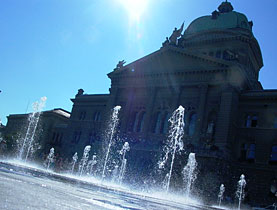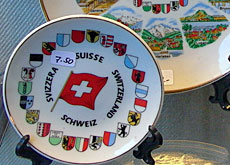Minority interests defended by power-sharing

Switzerland's political system is based on wide-ranging local and cantonal autonomy – in many ways an unusual example of a federalist structure.
But regular ballots that give voters the final say on constitutional amendments and laws also limit the powers of parliament.
As a rule, Europe’s democracies are defined by the constant antagonism between government and opposition.
But Swiss-style democracy is different not least as a result of the delicate balance of power between the various minorities and mentalities.
The set-up of the government has basically not changed over the past 60 years.
The four major political parties have been represented in the government since 1943 – albeit with different numbers of cabinet seats.
Roots
The fair representation of the country’s different regions and linguistic groups might no longer be as important as it used to – on paper at least.
However, the political colours as well as the geographical roots of a candidate still play a part in elections to the seven-member cabinet.
And, unlike many other countries, parliamentary elections don’t result in a single party securing a majority and therefore being able to form a government.
“Voters can at best influence the internal distribution of power among the main political parties,” said Daniela Ivanov, research fellow at Fribourg University’s Institute of Federalism.
Regions
The Swiss system is the result of a careful balance of powers and has historical roots.
It emerged from various alliances between the regions with their geographical characteristics as well as their linguistic, cultural and religious identities.
It was only in the 19th century that modern-day Switzerland began to take shape. The liberal founding fathers gave Switzerland a constitution in 1848 unifying the different cantons but leaving them a large degree of autonomy.
The formula also took into account the concerns of the French-, Italian- and Romansh-speaking minorities versus the majority German-speaking regions.
A fair power-sharing agreement deal was key for the new state to thrive and let the wounds heal from the 1847 civil war between liberal Protestant cantons and conservative Catholic regions.
American inspiration
The Swiss constitution was inspired by the constitution of the United States. Parliament is made up of two equal chambers with the House of Representatives – which represents the people – and the Senate, representing the country’s 26 cantons.
Unlike Germany, Swiss senators are not members of their respective cantonal governments. Instead they are elected by the people and have the same status as members of the House of Representatives.
Towards the end of the 19th century another element was introduced to balance out federalism and democratic principles.
Citizens won the final say in constitutional matters. Amendments to the country’s highest legal charter not only need approval by a majority of voters but also by a majority of the cantons.
This guarantees the small rural cantons some form of protection against large urban centres. However, the system remains controversial because it obviously goes against the “one man, one vote” rule.
“As a result a ballot sheet from a small canton ultimately counts much more than a vote cast in large and populous cantons such as Zurich, Bern or Vaud,” Ivanov pointed out.
Over the past 150 years the gap between the rural regions and the urban centres has increased, adding fuel to debates about electoral reform.

More
Federalism
Compromise
The founders of modern-day Switzerland also prepared the ground for compromise and consensus as cornerstones of Swiss politics.
The rural and Catholic cantons were allowed to keep a high degree of autonomy under the 1848 constitution. In the second half of the 19th century citizens won extended democratic right with the introduction in 1874 of the referendum – the possibility to challenge a new law in a nationwide vote – and the so-called people’s initiative in 1891.
Thus what was launched as a ‘winner-takes-all’ democracy gradually became a system that integrated an increasing number of political groups and segments of society, giving them a say in shaping law.
As part of the political procedure, members of the civil society, including NGOs, churches, employers and trade unions, are invited to state their opinion on a planned law.
What could be seen as a factor that unnecessarily complicates the political system aims to keep future opposition to the law to a minimum as joint action by groups fighting a project can easily block a bill.
“It ensures that the different minority groups get a say and the country’s delicate balance of power is not disturbed. But, at the same time, such a formula limits the possibilities for reforms and tends to hamper the transparency of parliamentary business,” said Ivanov.
“In a nutshell, when a bill reaches parliament there is often not much left to discuss as most compromises have been struck before,” she added.
Nearly two thirds (63.7%) of the Swiss population live in the German-speaking part of the country.
Just over 20% live in the western French-speaking part, while the population in the Italian-speaking region accounts for 6.5%. Romansh is only spoken by 0.5%.
Roman Catholics (41.8%) and Protestants (35.3%) are the two main religions in Switzerland. The Muslim community numbers 311,000 and the Jewish community 17,900, according to data by the federal authorities. Just over 15% have no religious affiliation.
Of the 7.8 million residents in Switzerland in 2010, more than five million live in urban areas, including 2.9 million who live in the five biggest cities. (Source: Federal Statistics Office)
The 200 seats in the House of Representatives are allocated according to the size of the population in the 26 cantons. Every canton – or constituency – is entitled to at least one seat.
The system of proportional representation was introduced in 1919 and – unlike Germany for instance – there is no minimum threshold of votes for a party to gain a seat.
In principle cantons have two seats in the Senate except for six small so-called half-cantons which have one seat each. Elections to the Senate vary from canton to canton, but they all use the first-past-the-post system.

In compliance with the JTI standards
More: SWI swissinfo.ch certified by the Journalism Trust Initiative




You can find an overview of ongoing debates with our journalists here. Please join us!
If you want to start a conversation about a topic raised in this article or want to report factual errors, email us at english@swissinfo.ch.